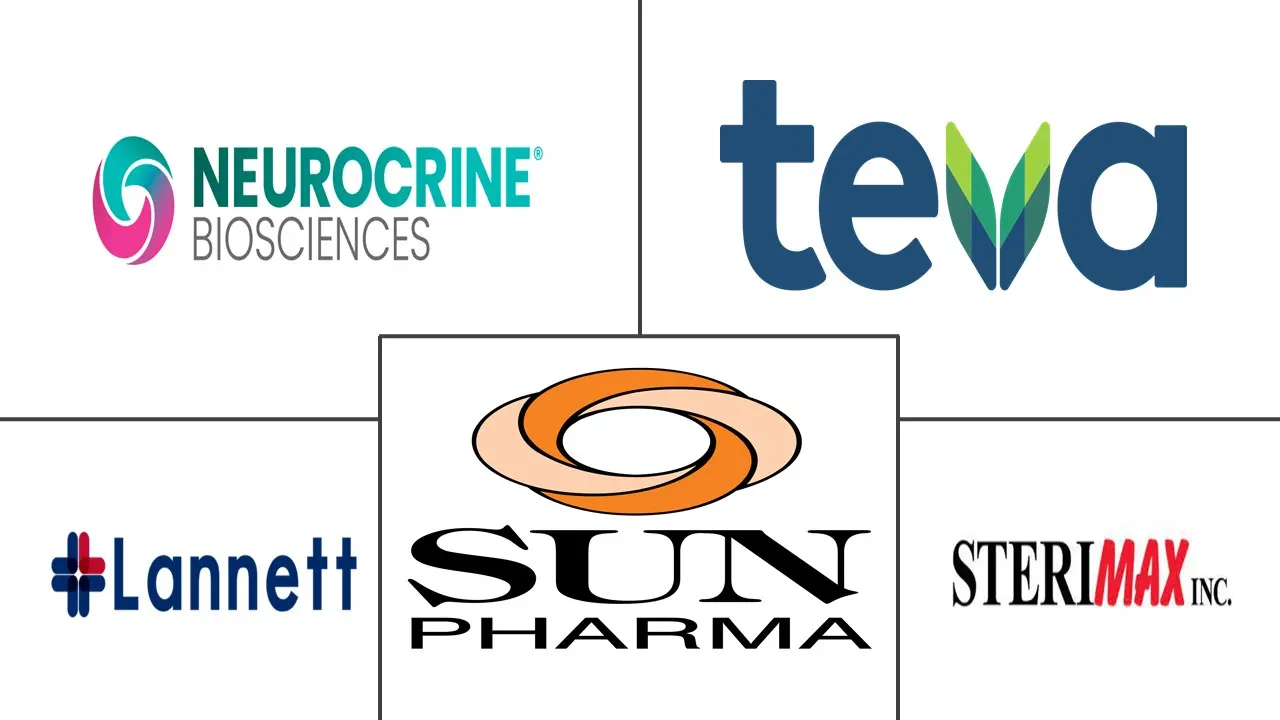Global Tardive Dyskinesia Treatment Market Size and Share
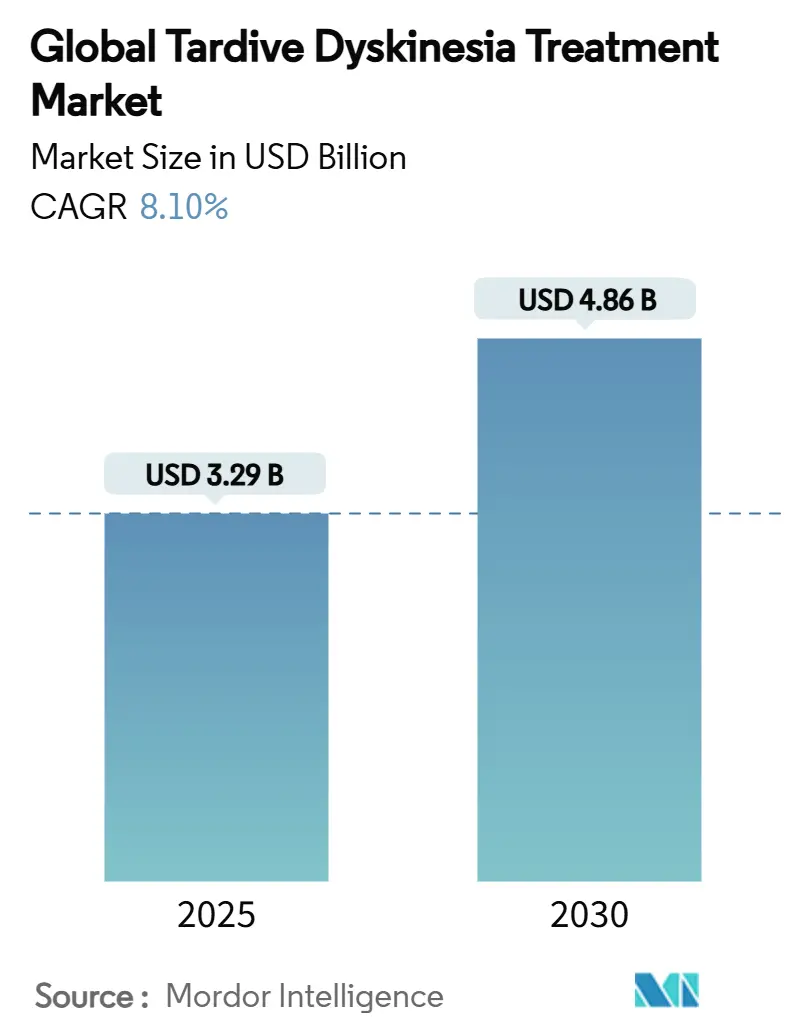
Global Tardive Dyskinesia Treatment Market Analysis by Mordor Intelligence
The tardive dyskinesia treatment market size is USD 3.29 billion in 2025 and is forecast to reach USD 4.86 billion by 2030, reflecting an 8.10% CAGR over the period. Sustained growth springs from continued VMAT2 inhibitor uptake, expanding payer coverage, and systemic efforts to close the diagnostic gap that leaves 85% of affected patients without a formal diagnosis. Competitive intensity is rising as generic valbenazine launches in the United States while Asia-Pacific authorities add deutetrabenazine to essential-drug lists, hastening regional demand. Formulation innovation, notably Teva’s once-daily Austedo XR and Neurocrine’s Sprinkle capsules, improves adherence and widens candidate pools. The uptrend is further reinforced by digital phenotyping tools and AI-enabled screening platforms that reduce the median 5.5-year diagnostic lag.
Key Report Takeaways
By disorder, hyperkinesia captured 72.13% revenue share in 2024 and is advancing at a 9.23% CAGR through 2030.
- By drug class, VMAT2 inhibitors held 70.10% of the tardive dyskinesia treatment market share in 2024, while the “Others” segment is forecast to expand at 9.63% CAGR to 2030.
- By route of administration, oral products accounted for 59.85% share of the tardive dyskinesia treatment market size in 2024 and will expand at a 9.44% CAGR between 2025 and 2030 .
- By distribution channel, hospital pharmacies led with 53.82% of the tardive dyskinesia treatment market size in 2024, whereas online pharmacies are growing at 10.48% CAGR through 2030.
- North America contributed 42.23% of global revenue in 2024, but Asia-Pacific is the fastest-growing region at 10.93% CAGR to 2030.
Global Tardive Dyskinesia Treatment Market Trends and Insights
Driver Impact Analysis
| Driver | (~) % Impact on CAGR Forecast | Geographic Relevance | Impact Timeline |
|---|---|---|---|
| Rising prevalence of antipsychotic-induced TD | +2.1% | Global | Medium term (2-4 years) |
| Approvals and reimbursement of VMAT2 inhibitors | +1.8% | North America & EU, expanding to APAC | Short term (≤ 2 years) |
| Growing clinician awareness and screening mandates | +1.5% | Global, strongest in developed markets | Medium term (2-4 years) |
| Digital phenotyping tools enabling early diagnosis | +1.2% | North America & EU core, spill-over to APAC | Long term (≥ 4 years) |
| Pipeline gene-expression modulators | +0.8% | Global, early focus North America | Long term (≥ 4 years) |
| Asia-Pacific essential-drug-list adoptions | +0.7% | APAC core | Medium term (2-4 years) |
| Source: Mordor Intelligence | |||
Rising Prevalence of Antipsychotic-Induced TD
Global TD prevalence among antipsychotic users stands at 25.3%, with first-generation agents driving higher incidence than second-generation compounds. Pandemic-era telemedicine widened care access but masked subtle movement symptoms, reinforcing under-recognition challenges even as the at-risk population grew. Evidence from the IMPACT-TD study revealed a 5.5-year median diagnostic delay, underscoring a latent pool of untreated patients now reaching specialist care via mandated screening programs. The tardive dyskinesia treatment market consequently benefits from a steady flow of newly identified cases independent of fresh disease incidence.
Approvals & Reimbursement of VMAT2 Inhibitors
The American Psychiatric Association recommends VMAT2 inhibitors as first-line therapy for moderate-to-severe TD, cementing their role in clinical algorithms. Copay assistance keeps 90% of Austedo users’ out-of-pocket costs at USD 10 or less, stimulating adherence. Medicare price negotiations under the Inflation Reduction Act introduce looming margin pressure, yet enhanced formulations such as Austedo XR and Ingrezza Sprinkle widen clinical appeal. This blend of policy tailwinds and reimbursement uncertainty sparks strategic differentiation around dosing convenience and support services, sustaining growth but heightening competitive stakes.
Growing Clinician Awareness & Screening Mandates
The RE-KINECT study quantified quality-of-life burdens stemming from unrecognized TD and catalyzed hospital-based screening protocols. Smartphone video assessments and the Tardive Dyskinesia Impact Scale supply objective metrics that streamline case finding and monitoring. Expanded training for non-specialist physicians mitigates neurologist shortages, accelerating diagnosis in community settings. As a result, patient funnel conversion rises, reinforcing prescription volume for established VMAT2 inhibitors and supporting future entrants.
Digital Phenotyping Tools Enabling Early Dx
Machine-vision algorithms now analyze gait, speech, and hand kinetics captured via consumer devices, enabling decentralized TD screening. FDA guidelines for patient-focused digital health create a clear authorization pathway that encourages integration into routine psychiatric care. Early deployments suggest hybrid workflows where AI pre-screens and clinicians confirm, boosting diagnostic sensitivity without sacrificing oversight. These tools add a technology-driven growth layer to the tardive dyskinesia treatment market as payers recognize long-term cost savings from earlier intervention.
Restraint Impact Analysis
| Restraint | (~) % Impact on CAGR Forecast | Geographic Relevance | Impact Timeline |
|---|---|---|---|
| High drug costs & limited coverage in EMs | -1.4% | Emerging markets globally, with acute impact in Latin America & Africa | Medium term (2-4 years) |
| Safety-profile concerns (somnolence, QTc) | -0.9% | Global, with heightened scrutiny in EU regulatory environment | Short term (≤ 2 years) |
| EHR-coding & ethnic under-diagnosis gaps | -0.8% | Global, with pronounced impact in diverse urban centers | Medium term (2-4 years) |
| Shift toward non-dopaminergic psych meds | -0.6% | North America & EU core, gradual adoption in APAC | Long term (≥ 4 years) |
| Source: Mordor Intelligence | |||
High Drug Costs & Limited Coverage in Emerging Markets
VMAT2 inhibitor list prices exceed many emerging-market reimbursement thresholds, dampening uptake despite rising clinical need. Specialty-pharmacy distribution forecloses generic substitution in most jurisdictions, tethering launch prices to U.S. benchmarks and constricting affordability. While patient-assistance programs bridge gaps, sustained manufacturer subsidies are necessary yet commercially unattractive in lower-income settings. Lupin’s generic valbenazine introduces a modest discount but still requires specialty handling, limiting broad-based price relief.
Safety-Profile Concerns (Somnolence, QTc)
Somnolence and QTc prolongation necessitate baseline and periodic monitoring, elevating treatment complexity in primary care and resource-constrained hospitals. The FDA boxed warning regarding depression and suicidal ideation compels psychiatric oversight, prompting cautious prescribing in multi-morbid populations. Interaction risks with CYP3A4 modulators further complicate medication management, potentially curbing expansion beyond specialist centers in the short run.
Segment Analysis
By Disorder: Hyperkinesia Drives Clinical Innovation
Hyperkinesia accounts for 72.13% of 2024 revenue and posts a 9.23% CAGR, underpinned by strong responsiveness to dopamine-depleting therapy. The tardive dyskinesia treatment market size for hyperkinetic presentations benefits from clear diagnostic criteria and objective movement-scale tools that enable timely intervention. Emerging gene-therapy research seeks durable modulation of dopaminergic signaling, aiming for disease modification rather than symptom suppression.
The hyperkinetic subtype’s predictability fosters prescriber confidence, reinforcing sustained demand. Bradykinesia remains clinically challenging since dopamine depletion can exacerbate symptoms, requiring nuanced dosing strategies. Nevertheless, real-world evidence from the KINECT-PRO study shows VMAT2 inhibitor benefits across psychiatric subgroups, encouraging broader adoption in mixed-phenotype patients.
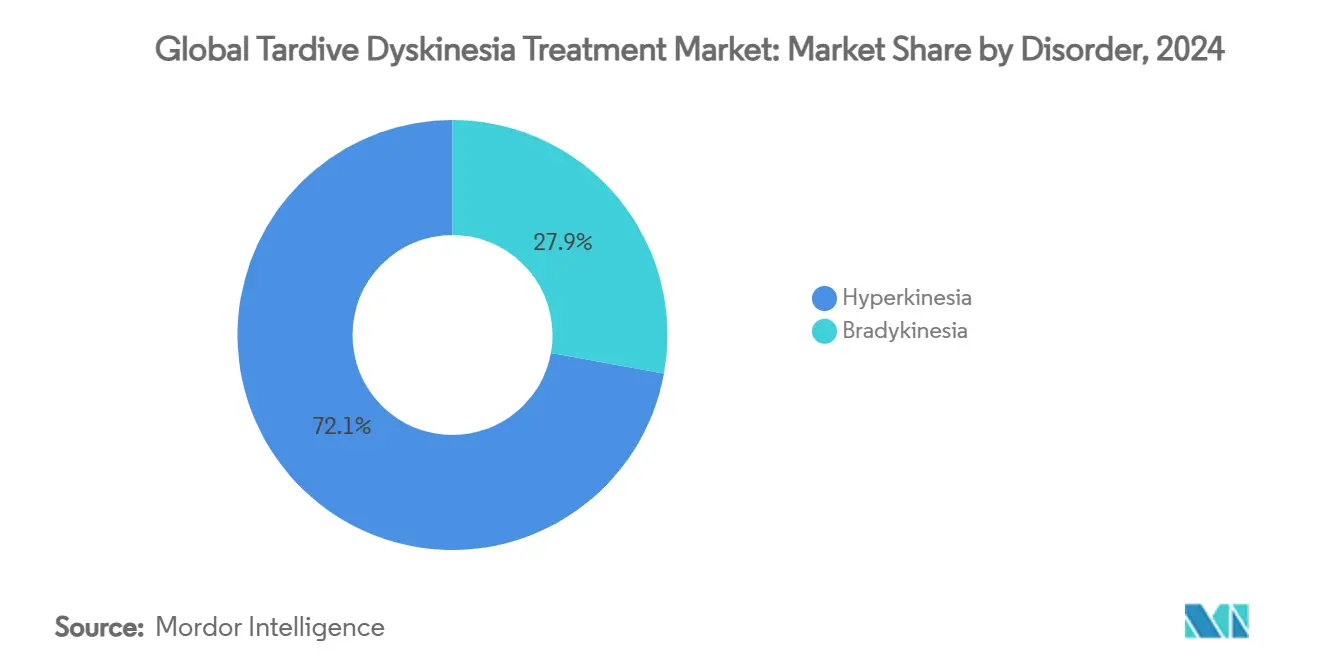
By Drug Class: VMAT2 Inhibitors Face Emerging Competition
VMAT2 inhibitors captured 70.10% share in 2024 but confront brisk 9.63% CAGR growth in the “Others” category. Reformulated valbenazine and deutetrabenazine products sustain class leadership, yet non-dopaminergic agents such as TAAR1 agonists and glutamate modulators gather momentum.
Extended-release VMAT2 tablets ease adherence while gene-expression modulators target causal pathways, foreshadowing a shift from symptomatic to disease-altering strategies. Anticholinergic agents continue to fade, reflecting guideline contraindications and inferior risk-benefit profiles. The drug-class landscape therefore bifurcates into entrenched depletors versus innovative preventives, shaping future investment flows within the tardive dyskinesia treatment market.
By Route of Administration: Oral Dominance Reinforced by Innovation
Oral formulations held 59.85% revenue in 2024 and will rise at 9.44% CAGR through 2030. The tardive dyskinesia treatment market size for oral products expands on the back of once-daily tablets and sprinkle capsules that address adherence and swallowing barriers.
Injectables remain niche, reserved for severe dysphagia cases, while pipeline transdermal systems aim to blend convenience with steady plasma levels. Digital adherence capsules—still investigational—could further entrench the oral route by integrating real-time ingestion tracking once regulatory pathways mature.
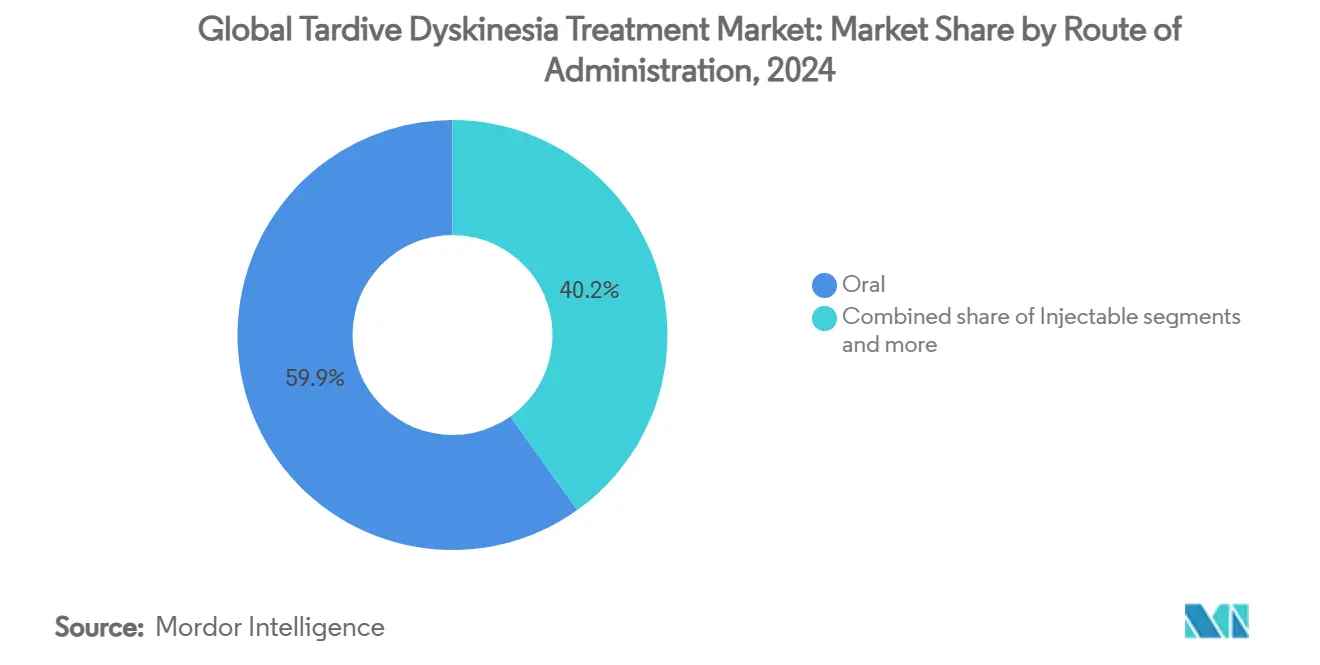
Note: Segment shares of all individual segments available upon report purchase
By Distribution Channel: Specialty Pharmacy Model Dominates
Hospital pharmacies generated 53.82% of 2024 sales, reflecting initiation oversight needs, yet online pharmacies lead growth at 10.48% CAGR. The tardive dyskinesia treatment market size flowing through e-commerce channels benefits from telehealth expansion and direct-to-patient logistics that flourished during the pandemic.
Specialty pharmacies integrate nursing support, prior-authorization services, and adverse-event triage, adding value beyond mere dispensing. Retail outlets lag due to limited counseling capacity for complex neurologic therapies but may regain share if simplified formulations reduce monitoring burdens.
Geography Analysis
North America dominated with 42.23% share in 2024 thanks to FDA approvals, insurance penetration, and structured specialty-pharmacy networks. Sustained screening initiatives and payer support counterbalance looming Medicare price negotiations, sustaining volume momentum even as revenue per prescription moderates. Generic valbenazine’s April 2024 debut applies gentle price pressure but preserves specialist-channel margins due to distribution safeguards.
Asia-Pacific races ahead at 10.93% CAGR, propelled by rising psychiatric drug usage and incremental policy wins such as Austedo’s China launch under the Teva–Jiangsu Nhwa alliance. Specialist shortages and out-of-pocket payment hurdles temper full-scale uptake, yet digital diagnostic tools bridge access gaps in markets like Japan and South Korea. Essential-drug-list additions and local manufacturing tie-ups could accelerate affordability, expanding the tardive dyskinesia treatment market base beyond premium urban centers.
Europe delivers steady growth as HTA agencies demand cost-effectiveness evidence, nudging manufacturers toward patient-reported-outcome data and risk-sharing agreements. Safety scrutiny drives conservative prescribing, particularly around QTc monitoring, yet comprehensive insurance buffers patient affordability. South America and Middle East & Africa remain nascent, constrained by limited neurologist density and budget priorities, but represent upside for tiered-pricing models aligned with national income levels.
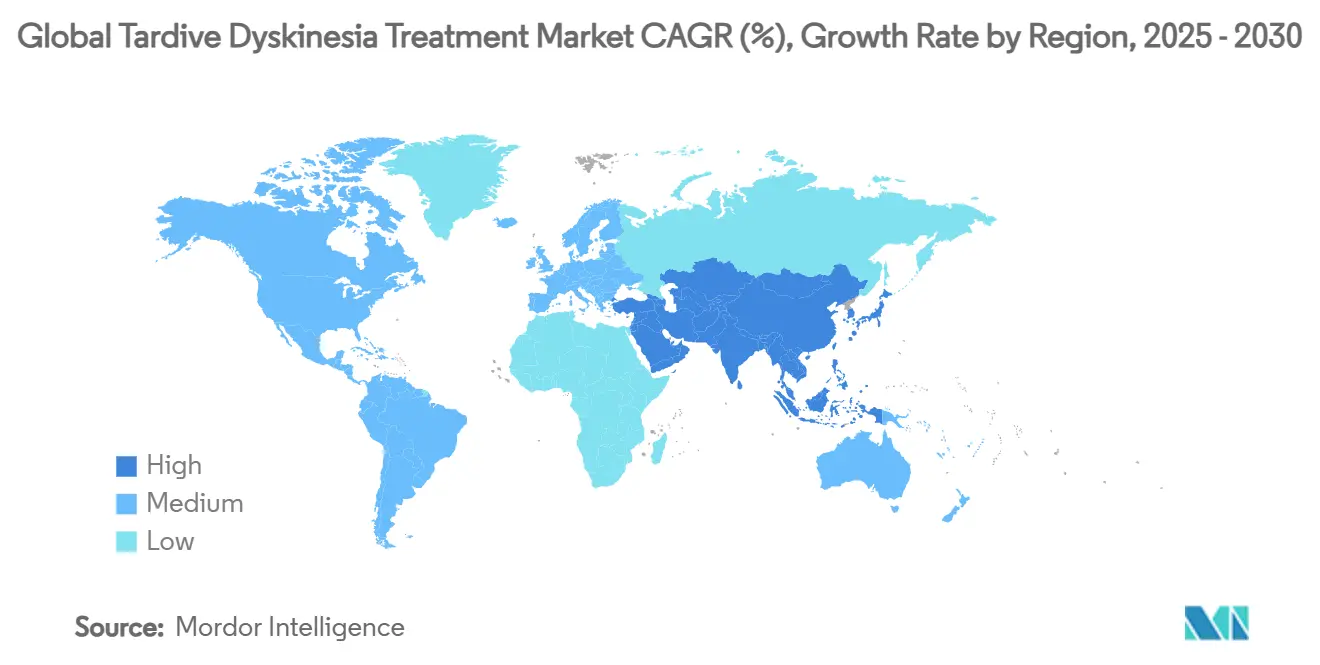
Competitive Landscape
Neurocrine and Teva together held roughly 85% share in 2024, translating into USD 3.9 billion combined sales. Ingrezza’s first-mover edge is reinforced by robust patient-support hubs, while Austedo capitalizes on once-daily dosing and expanding international reach. Formulation leap-frogging, not price cuts, remains the primary rivalry axis because specialty drug economics reward differentiation over discounting.
AbbVie’s USD 8.7 billion purchase of Cerevel Therapeutics injects fresh competition as tavapadon inches closer to TD trials, potentially introducing a new mechanism with less dopaminergic liability. Lupin’s generic entry opens the first budget alternative yet retains specialty-channel premiums, softening but not dismantling incumbent pricing power. Longer term, gene-therapy pioneers could upend the landscape if disease-modifying efficacy translates from Parkinson’s models to tardive dyskinesia.
Global Tardive Dyskinesia Treatment Industry Leaders
Neurocrine Biosciences, Inc
Teva Pharmaceutical Industries Ltd
Sun Pharmaceutical Industries Ltd
SteriMax Inc.
Lannett Co Inc
- *Disclaimer: Major Players sorted in no particular order
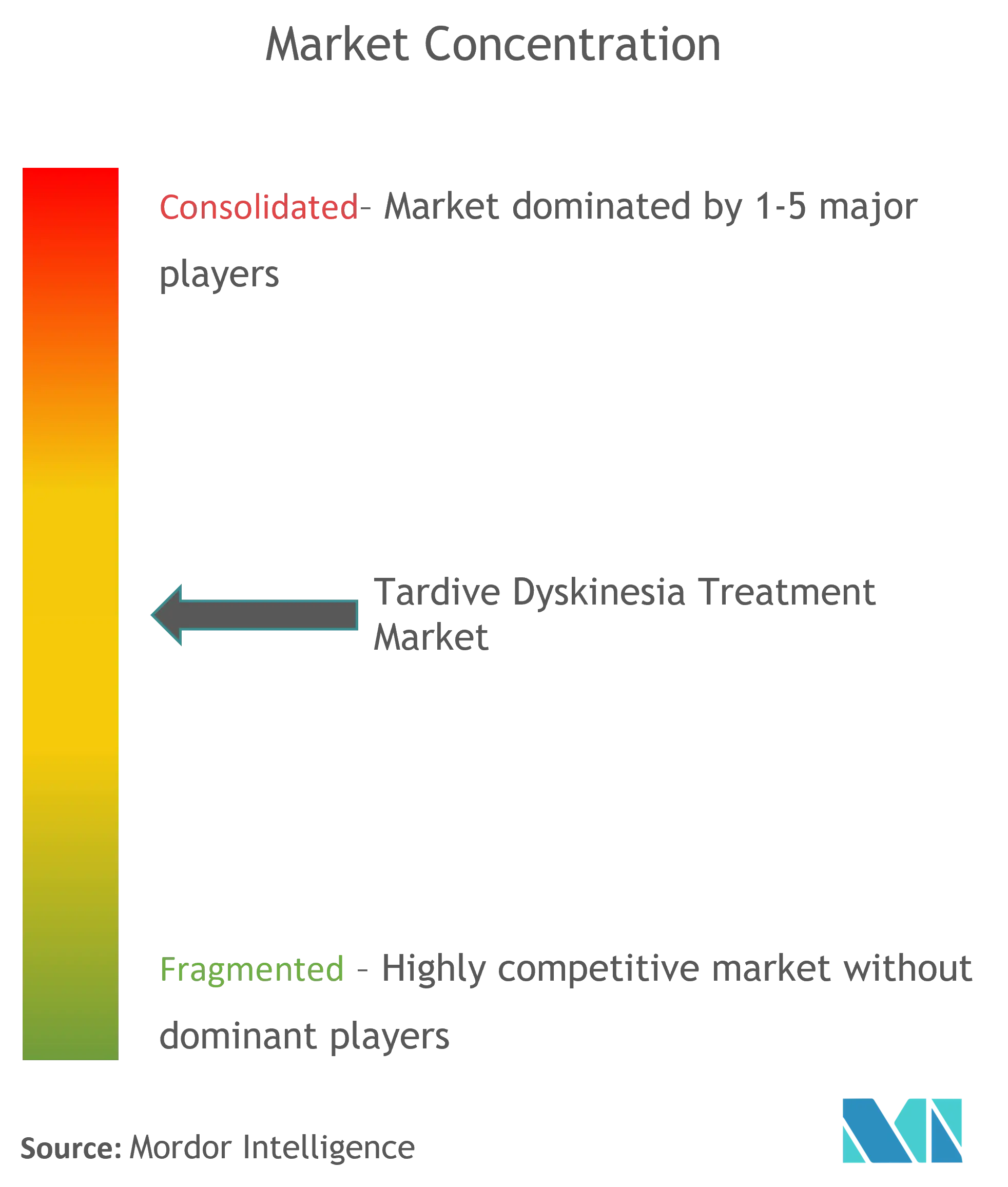
Recent Industry Developments
- February 2025: Neurocrine reported positive quality-of-life data from the KINECT-PRO Phase 4 study of Ingrezza, underscoring broad functional gains.
- May 2024: FDA cleared Teva’s once-daily Austedo XR tablets for TD and Huntington’s chorea, removing twice-daily adherence barriers
Global Tardive Dyskinesia Treatment Market Report Scope
As per the Scope, the Tardive Dyskinesia treatment market deals with the diagnosis of involuntary movement in the jaw, lips, and tongue. The Tardive Dyskinesia Treatment Market is segmented By Disorder (Bradykinesias, Hyperkinesias), Drug Class (Dopamine-Depleting Medications, VMAT2 inhibitors, GABA Receptor agonist medications, Anticholinergic Medications), End User (Hospitals, Clinics, Others), and Geography (North America, Europe, Asia-Pacific, Middle East & Africa, and South America). The market report also covers the estimated market sizes and trends for 17 different countries across major regions globally. The report offers the value (in USD million) for the above segments.
| Bradykinesia |
| Hyperkinesia |
| VMAT2 Inhibitors |
| Dopamine-Depleting Agents (non-VMAT2) |
| Anticholinergics & Others |
| Oral |
| Injectable |
| Others |
| Hospital Pharmacies |
| Retail Pharmacies |
| Online Pharmacies |
| North America | United States |
| Canada | |
| Mexico | |
| Europe | Germany |
| United Kingdom | |
| France | |
| Italy | |
| Spain | |
| Rest of Europe | |
| Asia-Pacific | China |
| India | |
| Japan | |
| South Korea | |
| Australia | |
| Rest of Asia-Pacific | |
| South America | Brazil |
| Argentina | |
| Rest of South America | |
| Middle East and Africa | GCC |
| South Africa | |
| Rest of Middle East and Africa |
| By Disorder | Bradykinesia | |
| Hyperkinesia | ||
| By Drug Class | VMAT2 Inhibitors | |
| Dopamine-Depleting Agents (non-VMAT2) | ||
| Anticholinergics & Others | ||
| By Route of Administration | Oral | |
| Injectable | ||
| Others | ||
| By Distribution Channel | Hospital Pharmacies | |
| Retail Pharmacies | ||
| Online Pharmacies | ||
| By Geography | North America | United States |
| Canada | ||
| Mexico | ||
| Europe | Germany | |
| United Kingdom | ||
| France | ||
| Italy | ||
| Spain | ||
| Rest of Europe | ||
| Asia-Pacific | China | |
| India | ||
| Japan | ||
| South Korea | ||
| Australia | ||
| Rest of Asia-Pacific | ||
| South America | Brazil | |
| Argentina | ||
| Rest of South America | ||
| Middle East and Africa | GCC | |
| South Africa | ||
| Rest of Middle East and Africa | ||
Key Questions Answered in the Report
What is the current value of the tardive dyskinesia treatment market?
The global tardive dyskinesia treatment market is valued at USD 3.29 billion in 2025
Which segment holds the largest share of the tardive dyskinesia treatment market?
Hyperkinesia dominates with a 72.13% share in 2024
What is the expected growth rate of VMAT2 inhibitors?
VMAT2 inhibitors are projected to grow in line with the overall 8.10% CAGR, maintaining leadership while facing competition from novel mechanisms
Why is Asia-Pacific the fastest-growing region?
Rapid regulatory approvals, rising antipsychotic use, and partnerships such as Teva’s deal with Jiangsu Nhwa drive Asia-Pacific’s 10.93% CAGR
